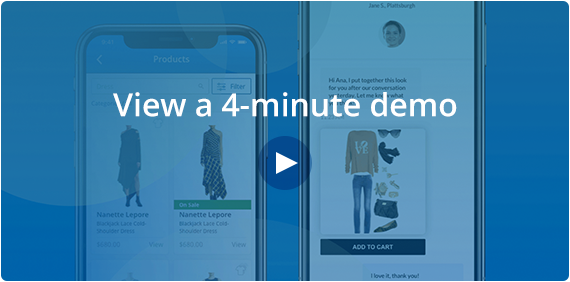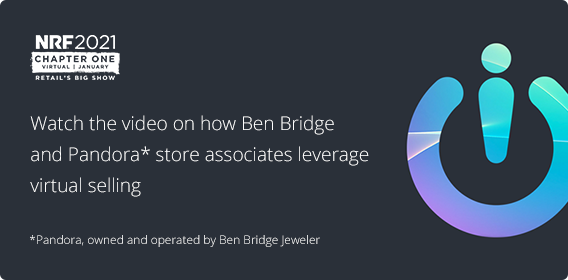How to Succeed at Virtual Selling:
Virtual selling has been around for ages, way before COVID-19 hit. Some might better know it as inside sales — a form of sales in which reps don’t need to step out of the office or store to meet customers in person.
Virtual selling today extends beyond phone calls. Retailers are meeting customers online with video conferencing solutions and remote communication platforms like live chat, e-mail, text messaging, and other messaging apps like WhatsApp.
Not surprisingly, in the wake of the pandemic, virtual selling has replaced face-to-face conversations almost entirely to become the new normal.
In fact, 71% of organizations today conduct more than half of their sales activities virtually as compared to a mere 27% in the pre-pandemic era.

This guide takes an in-depth look at the nitty-gritty of virtual selling and how to succeed at it.
Let’s get started. (You can also view a 4-minute demo here.)
What is virtual selling?
Gartner describes virtual selling as a collection of technologies and processes that enable salespeople to connect, engage, and communicate with prospects remotely. This can be accomplished through a number of channels including video, live chat, SMS, and email.
Besides ensuring everyone’s safety during a pandemic, virtual selling has proved to be a highly scalable sales strategy for the retail industry as online shopping surged in the last year. In fact, during the 2020 pandemic, digital customer interactions via Salesfloor increased by 300%, with the average associate serving 94 online customers per week.

Why implement virtual selling?
Retailers unlock several benefits by implementing virtual selling. Consider the following.
It helps you keep up with customers
It’s no secret that modern consumers shop across multiple channels and brand touchpoints. It’s not unusual for shoppers to use a combination of offline and online methods to research, browse, and buy.
In fact, shoppers today can use up to 12 channels and devices throughout their path to purchase.
When you have a robust virtual sales system in place, you’re in a much better position to keep up with customers as they move from one channel to the next. Having this technology in your stores enables store associates to meet and serve shoppers on the channels they are most comfortable with. These interactions are tracked to give you a better understanding of the customer journey.
Learn from Ben Bridge Jeweler’s relationship-building lessons.
It helps you stay competitive
Being able to sell virtually is proving to be a competitive advantage. According to a 2020 study by HubSpot, 64% of sales leaders that invested in a hybrid or fully virtual model met or exceeded their revenue targets, compared to 50% of leaders who didn’t invest in virtual selling initiatives.

However, virtual selling requires engaging, connecting, and building rapport with a prospect from behind a screen — which can be challenging if you don’t have the right tools and practices in place.
5 ways to improve virtual selling in your organization
Now that we’ve covered the basics, let’s take a look at some great virtual sales strategies that your store associates can benefit from. We’ll also look at some of the best virtual sales enablement tools that sales leaders should embrace to help their associates take their virtual selling skills to the next level.
1. Empower your teams to stay focused and organized
Distractions in virtual selling can ruin the experience for your customers. In a study by RAIN Group, 77% of buyers reported distractions (from notifications, people, and external disturbances) to be one of the biggest virtual selling mistakes.

With technology problems being at the top of the list, it’s very important that stores have reliable Wi-Fi access when using virtual selling technology. To keep distractions at bay, instruct your teams to ensure that managers and associates have enough space on-site to distance themselves from distractions or very noisy areas.
The RAIN Group study also reports that lack of preparation is a top virtual selling mistake, according to 83% of buyers.
So, equip associates with the resources they need to fully prepare for virtual sales conversations. Things like the customers’ browsing history as well as product photos and global inventory information are extremely helpful to have on hand before and during the meeting.
Finally, have your teams leverage pre-set email templates and graphics for prospecting, follow-ups, and setting the next steps after virtual sales calls. Having a proper follow-up procedure for every virtual interaction will ensure that nothing slips through the cracks.
Learn how Ben Bridge Jeweler and Pandora have adapted the role of their store associates.
2. Help stores create a professional setup
Now that the pandemic has exposed us to the myriad benefits of working in a virtual setting, remote sales might continue to be the new normal for years to come. So, it’s extremely important for sales reps to set up a professional-looking virtual environment.
Background. Your teams’ physical background should look presentable and on brand. Have your teams set up an area that’s clean and free of any clutter.
Lighting. See to it that each store’s virtual selling space is well lit with no dark shadows. Associates could sit facing a window, but if that’s not an option, equip them with ring or desk lights. Remember, your sales associates will be representing your brand, so it’s important to position in the best possible light — literally.
3. Make the experience visual and interactive
With people’s attention perpetually being in short supply, using visual and interactive elements in your teams’ virtual sales meetings can be a game-changer. In a survey by Corporate Visions, most salespeople reported that interactive visual storytelling techniques were the most effective at advancing a prospect or customer through the sales cycle.
The good news: if you’re in retail, you already have a leg up in this department. Associates who are interfacing with customers via video chat can create a highly visual experience simply by showcasing the brand’s merchandise. In live chat, e-mail or text messaging, clickable product images will act as visual cues to keep customers engaged while allowing them to come back to the recommended products later.
That being said, there are still a few things you could do to further optimize your initiatives. For starters, keep your internet connection in top shape. Even the best-looking merchandise will look lackluster when showcased over a choppy connection, so ensure that you have enough WiFi bandwidth to support video calls.
Pro tip: the minimum bandwidth requirement for video chat is 5 to 10MB per second download and 3 to 4 MB per second upload.
4. Don’t forget about live chat, SMS, and email
A lot of the pointers above can also be applied to channels like live chat, SMS, and email. Just like with video calls, professionalism is important. Customers may not be able to see team members or their background, but the words and tone used in their message can speak volumes.
That’s why it’s critical to emphasize the importance of staying professional, keeping everything on brand, and minimizing distractions.
Visuals are also essential. Have your associates incorporate product photos or videos into live chat sessions, text messages, and email.
Last but not least, encourage your teams to be prompt with their responses, especially when using tools like SMS and live chat. Industry data shows that 77% of consumers expect an instant response when communicating via live chat, while the average response time for SMS is just 90 seconds.
As for email, the average response time for retail businesses is 17 hours, though large companies like Abercrombie and Disney’s retail department brought down their email response times to just under 2 hours.
To stay competitive, make sure your response times meet and beat those benchmarks.

5. Leverage the right tools and technology
The right technology and tools can not only streamline your virtual sales process but also automate a number of activities to increase efficiency. To succeed at virtual selling, your teams need tools that can protect their focus, increase productivity, enable high-quality video calls, and help them engage audiences effectively.
Here are some of the best tools that you could adopt at the organizational level to help your teams succeed at virtual selling.
Salesfloor
Particularly suited for the retail industry, Salesfloor enables sales associates to provide personalized virtual shopping experiences to online customers.
With Salesfloor Connect, you can help online shoppers connect with a local sales associate directly via live chat, video, text, or email from any page of your website and get real-time assistance. Plus, customers can request virtual or in-store appointments with an associate using an online widget.
Another thing that sets Salesfloor apart is it brings multiple virtual selling channels into one solution, so shoppers can choose how they want to interact with associates. Unlike call centers and chatbots, Salesfloor can connect customers to an associate at their local store, as opposed to routing them to a cell center or the head office.
And since Salesfloor offers multiple features on the same platform (e.g., chat, SMS, appointments, etc) the whole experience feels seamless — both for customers and associates.
Salesfloor helps associates build strong customer relationships (and increase sales) by offering virtual co-shopping experiences. Customers can share their screen and navigate your ecommerce store with the help of an associate who provides real-time assistance and recommendations.
Salesfloor also has reporting capabilities, enabling retailers and their in-store teams to track sales and measure results.
Detailed sales tracking across channels also enables associates to get credit for sales that occur virtually, thus encouraging them to sell even more.

Stylitics
Perfect for retailers that sell apparel and accessories, Stylitics is an outfitting and styling platform that makes it easy for associates to create looks and outfits for customers. The software can put together thousands of outfits using store-specific inventory, so your retail associates can save time and find products quickly and easily during calls.
A tool like Stylitics makes virtual selling more engaging and personalized. It helps associates provide tailored recommendations and outfit ideas, ultimately offering more value to the customer.
Freedom
Freedom can keep most distractions at bay by blocking websites, apps, and games on your computer and the user’s phone. You can choose to block specific apps and websites for any length of time per your discretion. Freedom can sync across all your devices and is compatible with Windows, Mac, iOS, and Android.

Bringing it all together
While many selling principles like rapport-building, needs discovery, and communicating value, essentially remain the same, the manner in which sales teams can accomplish them in a virtual environment is quite different.
From the background and lighting to audio and video, associates need to make the virtual sales experience as pain-free and seamless as possible for your customers. It’s also important to keep disruptions and distractions at bay and manage goals, environment, and time proactively.
The advice above will go a long way in helping your teams reclaim their time and focus and build stronger relationships with your customers through virtual selling.
Need a virtual selling solution for your retail sales associates? Salesfloor gives you everything you need to engage shoppers on any channel. Request a demo today.

